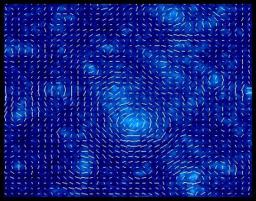Jean-Luc Starck, an experienced research scientist at IRFU (the CEA Institute for Research on the Fundamental Laws of the Universe) was awarded a 2.2 million euro grant spread over five years under the 7th European research and development framework programme (FP7). The grant comes in recognition of Mr Starck's research project in statistics, signal and image processing and its applications to astrophysics.
Aimed at funding investigator-driven, frontier research, "Ideas" is a specific FP7 programme set up to promote excellence and create economic value and growth from very high-level projects. The programme is run by the European Research Council (ERC) and involves 22 leading European scientists, with a budget of 7.4 billion euros over seven years (representing some 15% of the FP7 budget). It provides grants for two categories of scientist: young research scientists starting out and advanced scientists.
Following the success of three young CEA scientists in 2007, Jean-Luc Starck, a research scientist at IRFU, part of the CEA's Physical Sciences Division, was awarded the grant for advanced scientists in October 2008 for his project entitled "Sparse Representation of Multivalued Images: Application in Astrophysics". What makes the project particularly original is its multidisciplinary nature, for it lies at the crossroads between three major disciplines – statistics, signal processing and astrophysics. It sets out to find a theoretical and algorithmic solution to meet the challenges involved in analysing the new generation of astrophysical data and to propose new ways of addressing a wide range of issues, such as the analysis of the cosmic microwave background or reconstructing maps of dark matter. It ties in perfectly with the major space projects in which IRFU is involved, especially the PLANCK, HERSCHEL, GLAST and EUCLID/DUNE space programmes.
Jean-Luc Starck obtained his PhD from the Observatoire de la Côte d'Azur in 1992 and his authorisation to supervise research from the University of Paris XI in 1999. He was Visiting Scientist at the ESO (European Southern Observatory) in 1993, at UCLA (University of California, Los Angeles) in 2004 and at Stanford (USA) in 2000 and 2005. He has been a research scientist at the CEA since 1994. His research activities concern image processing, statistical methods in astrophysics and cosmology. He is an expert in multiple-scale methods such as wavelets and curvelets.
He manages the Multiresolution project at the CEA and is a scientist in the GLAST and PLANCK projects. He has published more than 100 articles in journals with a reading committee and is the author of two works entitled "Image Processing and Data Analysis: the Multiscale Approach" (Cambridge University Press, 1998) and "Astronomical Image and Data Analysis" (Springer, 2nd edition, 2006). Jean-Luc Starck's team reports to IRFU's Electronics, Detectors and Computing Division, the activities of which focus particularly on technology and instrumentation, and to the Astrophysics Division's Cosmology Laboratory.
By increasing the scope of the team's activity, the project headed by Jean-Luc Starck seeks to further develop the theoretical approach to representing and analysing complex data, produce advanced software tools for the community and optimise scientific feedback from the PLANCK, HERSCHEL, GLAST and EUCLID/DUNE programmes.
Links for more information:
project GLAST
Project PLANCK
Project DUNE/Euclid
Jean-Luc Starck's personal page
Contact:
• Innovation for detection systems Modelisation, calculation and data analysis Structure and evolution of celestial bodies
• Department of Astrophysics (DAp) // UMR AIM • The Electronics, Detectors and Computing Division




